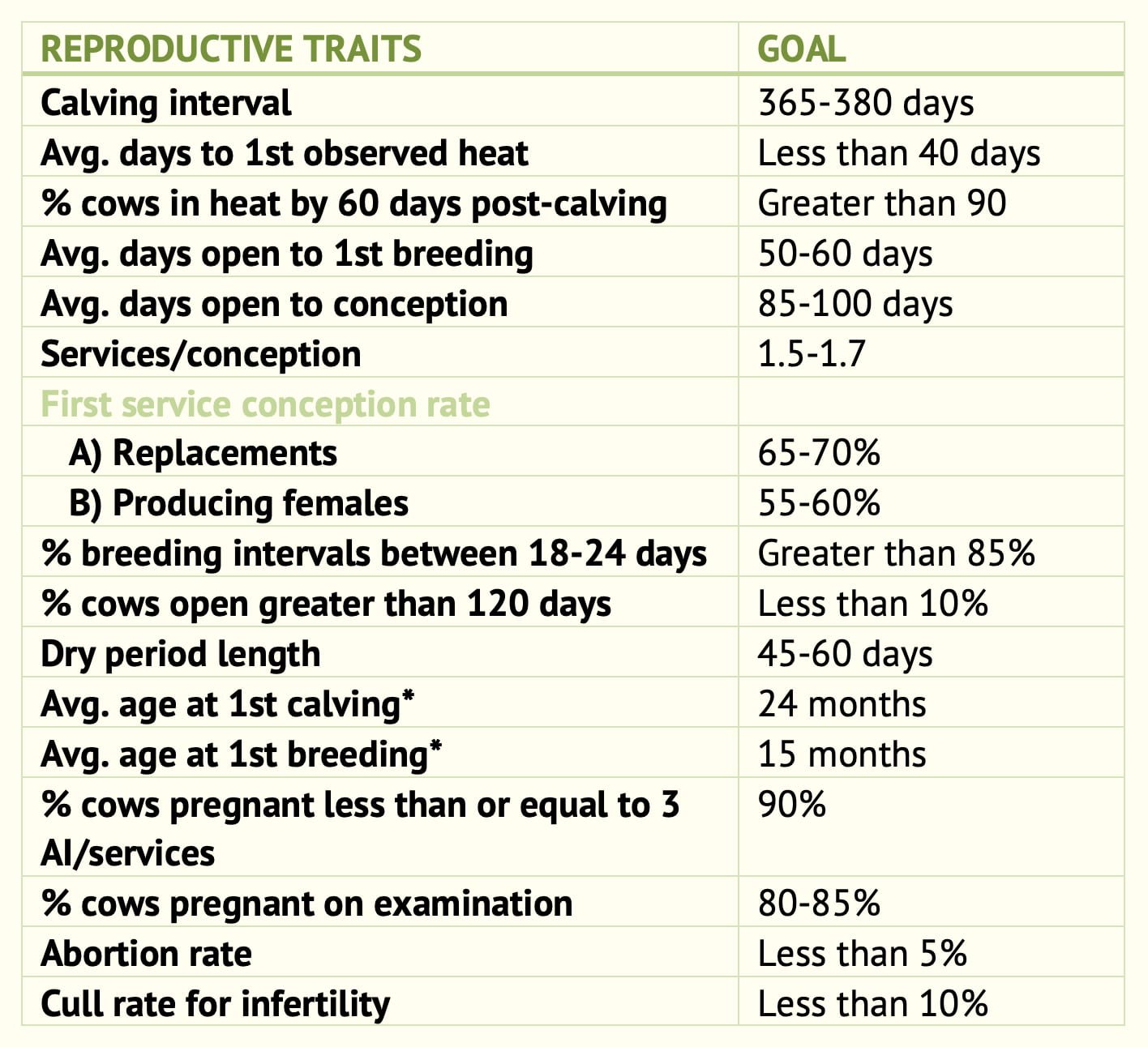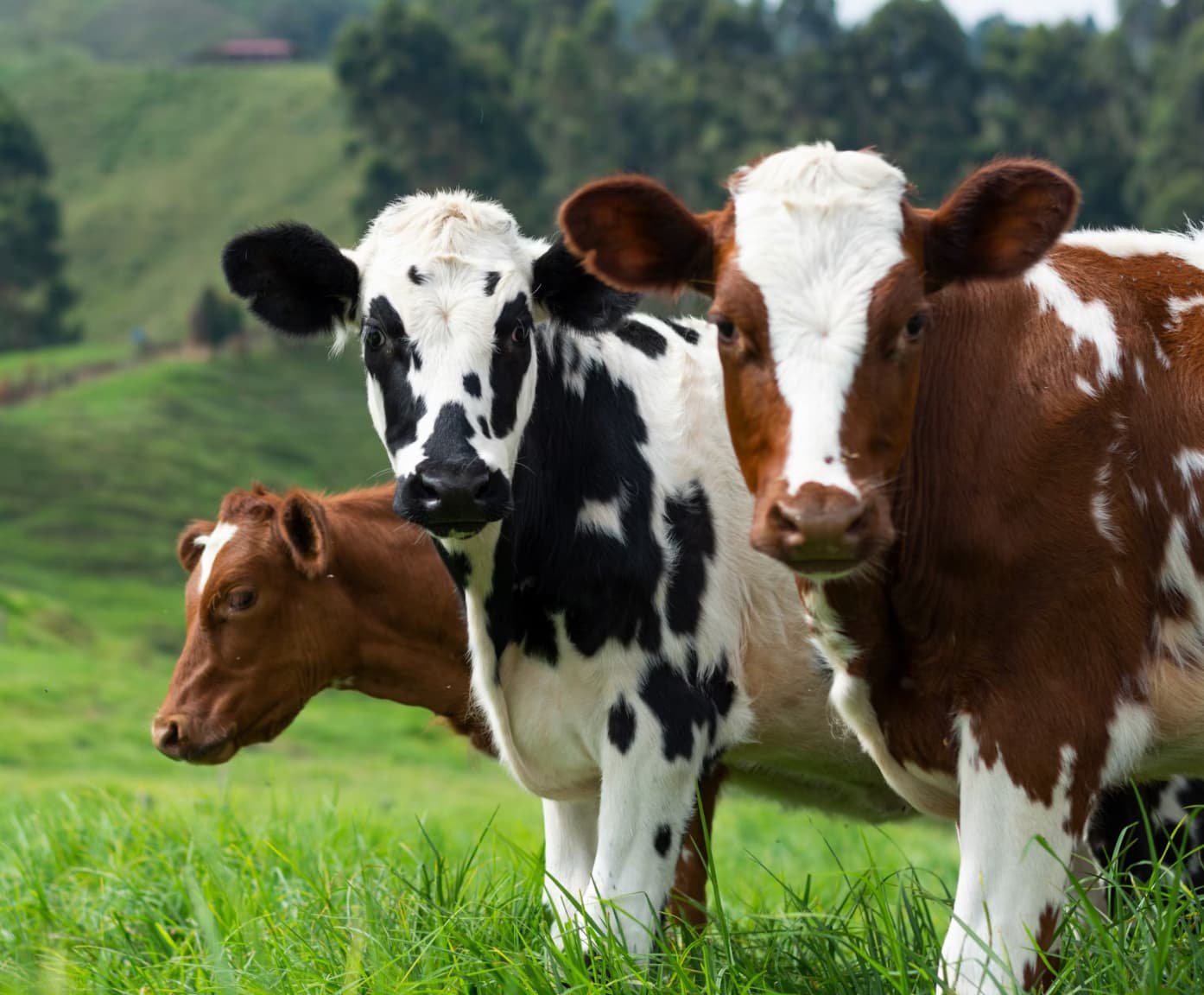TABLE OF CONTENTS
Normal Targetable Herd Fertility Parameters
Normal targetable herd fertility parameters in animals are essential for efficient reproductive management and overall herd productivity.
Fertility parameters typically include conception rate, pregnancy rate, calving or lambing interval, and the percentage of animals returning to estrus.

Non-Return Rate to First Insemination
This is the percentage of cows or heifers, in a particular group, which have not been presented for a repeat insemination within a specific period of time.
The periods are usually 30-60 days or 49 days.
This is used, particularly in artificial insemination centers, to monitor the fertility of bulls and the performance of inseminators.
Calving Interval and Calving Index
The calving interval is the interval in days for an individual cow between successive calvings; the calving index is the mean calving interval of all the cows in a herd at a specific point in time, calculated retrospectively from their most recent calving date.
These two measurements have been used traditionally as a measure of fertility, since they indicate how closely the individual cow or herd approximates to the accepted optimum of 365 days.
The disadvantages of these measurements are that they are historical in that they are calculated retrospectively; furthermore, the calving index can give an overoptimistic assessment of fertility when many of the cows that fail to become pregnant are culled.
Calving to Conception Interval
The calving interval (or index CI) is the sum of two components, (a) the interval from the last calving date to the date of conception and (b) the length of gestation thus:
- CI = a + b
- Therefore, CI = 85 days + 280 days = 365 days.
The calving to conception interval (CCI) is calculated by counting the number of days from calving to the service which resulted in pregnancy (effective service); this is usually the last recorded service date. The CCI is a useful measurement of fertility but requires a positive diagnosis of pregnancy to be made. It is influenced by two factors; how soon after calving the cows are served or inseminated and how readily they become pregnant when they have been served.
The CCI can be expressed thus:
- Mean CCI = c +d
- Where ‘c‘ is the mean calving to first service interval and ‘d‘ is the mean first service to conception interval, therefore
- Mean CCI = 65 days + 20- days = 85 days.
The mean CCI is a useful measure of fertility, provided that the interval from calving to first service is stated, since this probably will have the greatest influence upon its length.
Days Open
This is defined as the interval, in days, from calving to the subsequent effective service date of those cows that conceive, and from calving to culling or death for those cows that did not conceive.
Numerically, it will always be greater than the mean CCI unless all cows that are served conceive, in which case it would be the same.
Days open (%) = (Total service period in days in all lactations /Total herd life in days) x 100
Calving to First Service Interval
In the case of a herd that calves all the year round a mean value of 65 days should result in a mean CCI of 85 days. The factors that influence the calving to first service interval are:
- Although cows will return to estrus after calving as early as 2-3 weeks, they should not be served before 45 days, and in the case of first calving, highyielding cows and those that have had dystocia and problems during the puerperium slightly longer time should elapse.
- Delayed return of cyclical activity after calving, i.e. true anestrus.
- Failure to detect estrus in those cows that have resumed normal cyclical activity.
Factors (2) and (3) can be improved by ensuring that cows have returned to cyclical activity postpartum. This can be done by regular and routine examination of those cows, per rectum, that have failed to be seen in estrus by 42 days postpartum and by the use of milk progesterone assays.
Overall Pregnancy Rate
This (originally called the overall conception rate) is the number of services given to a defined group of cows or heifers, over a specified period of time which result in a diagnosed pregnancy not less than 42 days after service; the figure is expressed as a percentage of the total number of all services and should include culled cows.
The pregnancy rate is influenced by:
- The correct timing of artificial insemination, which will be dependent particularly on the accuracy of estrus detection.
- Correct artificial insemination technique, handling and storage of semen.
- Good fertility of the bull if natural service is used, and the absence of venereal disease.
- Adequate nutritional status of cows and heifers at the time of service and afterwards.
- Complete uterine involution and absence of uterine infection.
In order to identify the influence of management changes, particularly nutrition, it is worthwhile calculating these two parameters on a monthly basis provided that there is a minimum of 10 services per month.
Estrus Detection Rate
It is possible to estimate the estrus detection rate but it is important to stress that it is an estimate and not an accurate measurement.
A number of different methods are used and they all have some measure of inaccuracy. One method is to determine the number of supposed missed estrous periods. This an interval of 36-48 days suggests that one estrus has been missed and an interval of 54-72 days suggests that two have been missed, although this latter range is fairly wide and can lead to errors. The percentage of estrus detection rate (EDR) is calculated thus:
- Estrus detection rate (%) =(No. of interservice interval recorded /(No. of interservice interval recorded + No. of missed estrous period) ) x 100.
- Efficiency of estrus detection (%) = (No. of estrus detected / Total No. of estruses ) x 100.
- Accuracy of estrus detection (%) =(No. of estrus detected / (No. of estrus detected + No. of false estrus detection ))x 100.
One simple method of assessing the estrus detection rate at routine sessions of pregnancy diagnosis will be the number of cows that are assumed by the herdsman to be pregnant, and thus submitted for examination, but are found to be non-pregnant.
Non-pregnant cows should have returned to estrus since service or artificial insemination, and hence should have been seen in estrus.
Poor estrus detection may be due to:
- Poor accommodation inhibiting cows from exhibiting overt signs of estrus.
- Poor lighting or identification of animals.
- Failure to record signs of approaching estrus and signs of true estrus.
- Inadequate regimen for observing cows for signs of estrus, perhaps due to the herdsman being overworked.
First Service Submission Rate
- A days in all-the-year-round calving herds, then she should be served or inseminated within the next 21 or 24 days.
- However, pregnancy rates will probably not reach their optimum for at least 90 days postpartum.
- Heifers, and cows yielding more than 40 litres per day, should not be served before 50 days postpartum.
- The submission rate is influenced by:
- the time interval to the resumption of normal cyclical activity after calving, and
- the detection of estrus in those cows that have resumed normal cyclical activity, and their presentation for service or artificial insemination.
- A good submission rate is 80per cent In seasonally calving herds it will tend to be higher in those cows that calve earlier than in the later calving.
- Submission rate (%) = (No. of cows or heifers served within a 21 days period / No. of cows or heifers that are at or beyond the start of the 21 days period) x 100.
- Another method is to list all cows chronologically in order of the calving date. Add 21 days to the earliest date on or after which they are ready for service, i.e. 45 + 21 (24) = 66 (69) days. Thus every cow should be served before the target date of 66 or 69 days postpartum. The submission rate is calculated thus:
- No of cows served on or before the target date / No. of cows that should have been served on or before the target date.
Reproductive Efficiency
Reproductive efficiency is calculated thus:
- RE = (Submission Rate X Overall Pregnancy Rate) / 100
Thus if the submission rate is high, i.e. 80per cent and the overall pregnancy rate is good, i.e. 55 per cent, then the RE is 44.
The advantage of this measurement is that an artificially high submission rate, obtained by an overzealous herdsman presenting cows for artificial insemination when they are not in estrus, will be compensated by a reduced pregnancy rate. Conversely, an overcautious herdsman may have a reduced submission rate but although the reasonable RE value, it is not possible to increase this further.
Culling Rate
One method of achieving a CI around 365 days is by culling those cows that are slow to get in calf.
This is rarely cost-effective because it will be necessary to replace the culled cow with a heifer.
The purchase price or the cost of rearing such a replacement is much greater than the price obtained for the cull.
Overall culling figures for infertility should not exceed 5per cent; thus 95per cent of the cows that calve and are served should become pregnant again.

